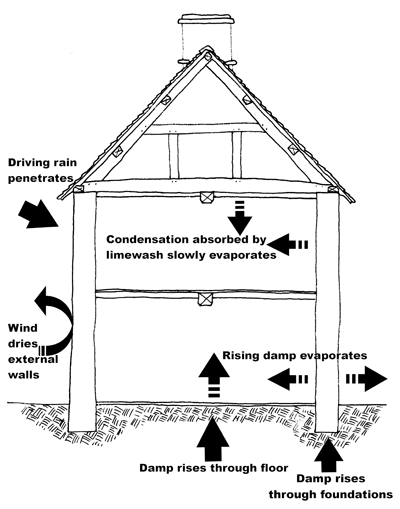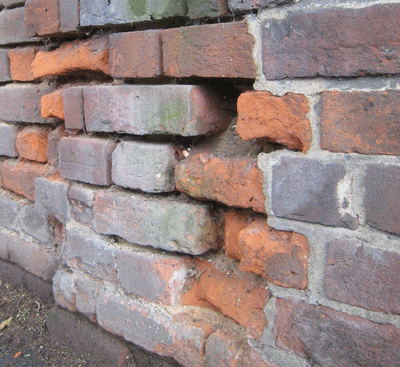Old houses: The importance of using the right materials
You can't use modern materials on period properties because they upset the original mechanism for how the building breathes. Alan Tierney explains.

If you have been involved in caring for or repairing an old house you will have heard about the importance of 'breathability'. I hope you will have heard it early on and often because it really is vitally important. But what does it mean?
To start with it doesn't involve air (as the word implies) but water. Breathability relates to how water moves through structures and the ability of materials to absorb and release water both as vapour and as liquid. This is critical to the performance of an old building because water affects everything from possible decay of building fabric, through its thermal performance, to the health of occupants.
So far so good, but it often confuses people that breathability is so important for old buildings when modern buildings manage perfectly well without using breathable materials. This is because there are fundamental differences between the way buildings are constructed now and how they were built until the early 20th Century.

Modern buildings are built to be waterproof - they incorporate impervious materials (hard dense bricks, cement based mortars and renders, modern masonry paints and external sealants), which rely on providing physical barriers to keep out driving rain and damp-proof courses to prevent rising dampness. Used correctly in the construction of new buildings, such materials and methods work well and will exclude the elements, as long as they are maintained.
Old buildings are usually built of stone, brick, timber and earth (cob or wattle and daub) held together with earth or lime-based mortars, often covered with earth or lime based plaster, render or paint. These materials are absorbent and allow moisture to penetrate the fabric and then evaporate away harmlessly when conditions are favourable - they are breathable.
Dampness in an old building is controlled by this regular evaporation of moisture. Externally the porous materials are dried out by the wind and sun. Internally, air movement - through the roof covering, windows and openings - promotes evaporation of moisture from the internal surfaces. Where moisture can evaporate freely the fabric will remain relatively dry.

If impervious modern materials are used on an old building, the balance between water entering the fabric and evaporating from it will be disturbed. The breathing performance will be adversely affected and problems, including dampness and decay, will occur. Vulnerable materials, such as timber and soft bricks or stones, are particularly at risk.
Sign up for the Country Life Newsletter
Exquisite houses, the beauty of Nature, and how to get the most from your life, straight to your inbox.
To make matters worse, modern cement-based renders, mortars and plasters are hard and inflexible. If they are used over softer, more flexible traditional materials they will tend to crack. Even the finest hairline crack will allow water to enter and any moisture drawn in will become trapped behind the impermeable finishes.
Where modern impervious materials are causing problems of dampness and decay they should ideally be removed but this can itself cause considerable damage if it's not done with great care. All work to old buildings should be carefully specified and carried out by skilled craftspeople to minimise the risk.
At first sight this seems very restrictive - eliminating nearly everything you will find in your local builders' merchant or DIY store from use in an old building. In fact there is a surprisingly wide, and growing, range of breathable materials available. Lime still heads the list, as it has done for thousands of years - the world's most proven manufactured building material - but it is joined by clay-based plasters and paints, insulation and walling materials incorporating woodfibre, hemp, recycled newspaper, sheepswool and more. You can find companies selling these materials in the Products Directory on ProjectBook.
A word of warning, however: treat manufacturers' claims of breathability with caution and ensure that materials are specified by someone who has both expertise and experience of their use in old buildings.
Alan Tierney is a historic building consultant. He runs Picketts Historic Building Conservation, advising clients on all aspects of the care, maintenance and alteration of historic buildings. This includes specifying, using and assessing a range of breathable and sustainable materials to protect the integrity and value of our precious resource of old buildings.

This is an article from ProjectBook which provides a wide range of information for the conservation, restoration, care and repair of period and listed buildings. Picketts Conservation is a member of the Heritage Register which contains over 500 vetted craftsmen, contractors and consultants from all over the UK. Updated daily with new content, the website features the heritage register, a products directory, informative articles, current news, events and more. For more information, visit www.projectbook.co.uk
Country Life is unlike any other magazine: the only glossy weekly on the newsstand and the only magazine that has been guest-edited by HRH The King not once, but twice. It is a celebration of modern rural life and all its diverse joys and pleasures — that was first published in Queen Victoria's Diamond Jubilee year. Our eclectic mixture of witty and informative content — from the most up-to-date property news and commentary and a coveted glimpse inside some of the UK's best houses and gardens, to gardening, the arts and interior design, written by experts in their field — still cannot be found in print or online, anywhere else.
-
 Athena: We need to get serious about saving our museums
Athena: We need to get serious about saving our museumsThe government announced that museums ‘can now apply for £20 million of funding to invest in their future’ last week. But will this be enough?
By Country Life Published
-
 Six rural properties with space, charm and endless views, as seen in Country Life
Six rural properties with space, charm and endless views, as seen in Country LifeWe take a look at some of the best houses to come to the market via Country Life in the past week.
By Toby Keel Published
